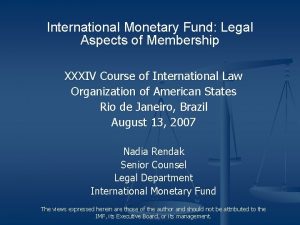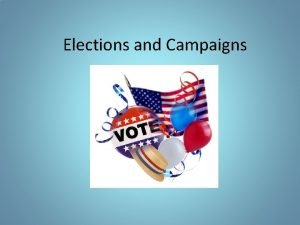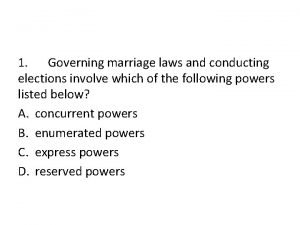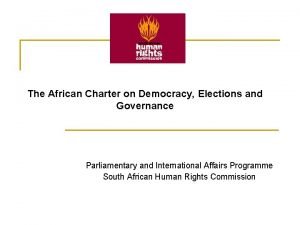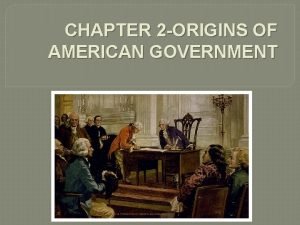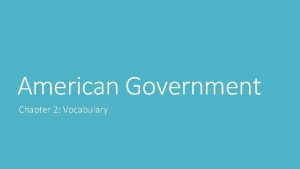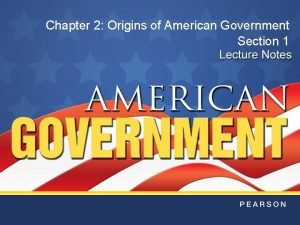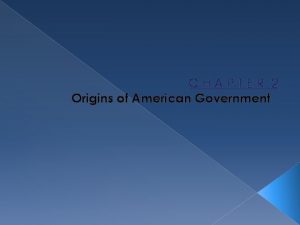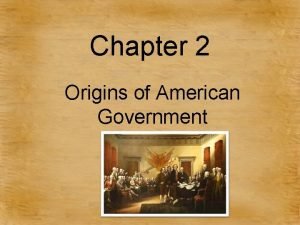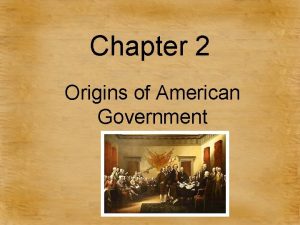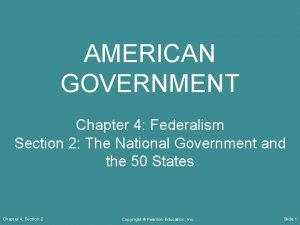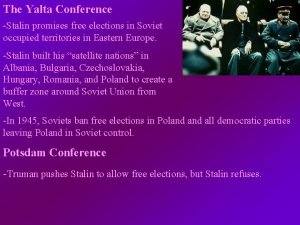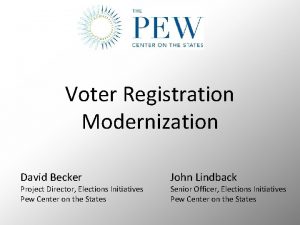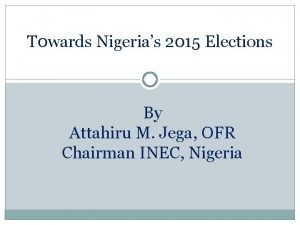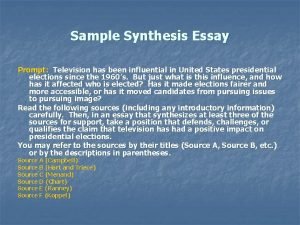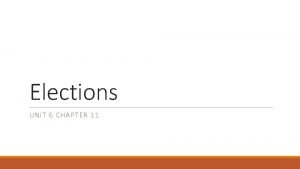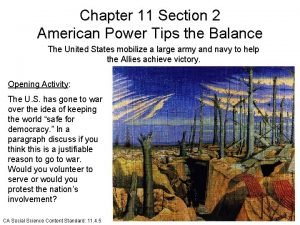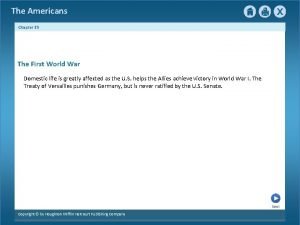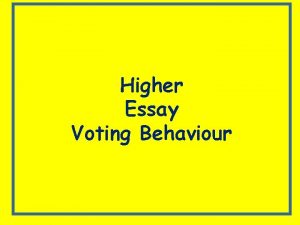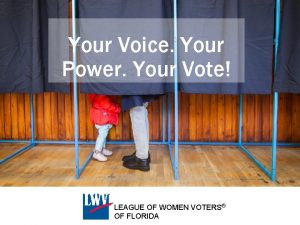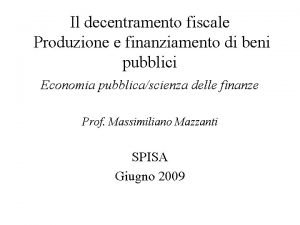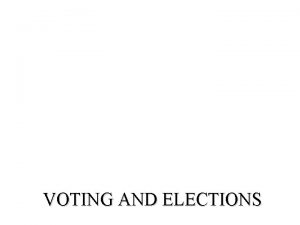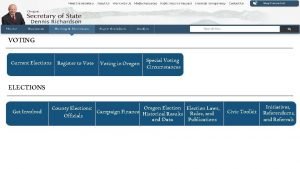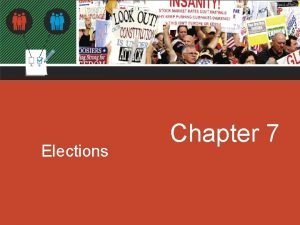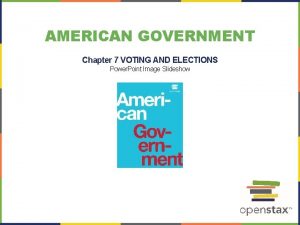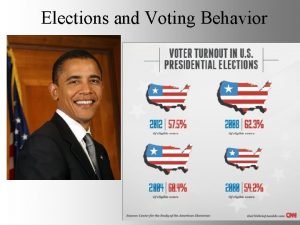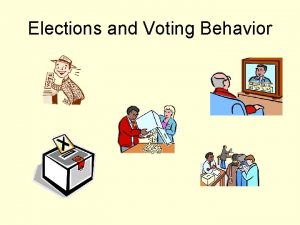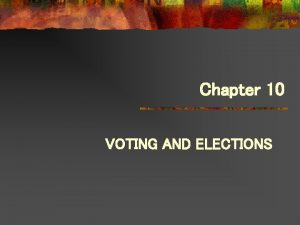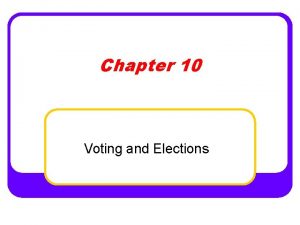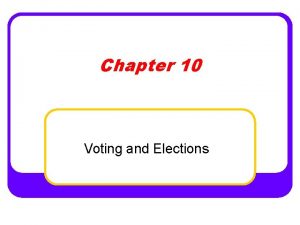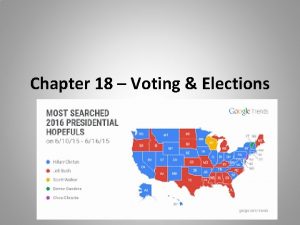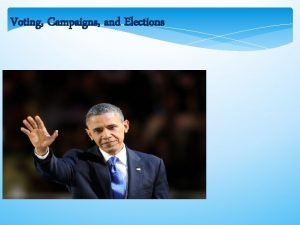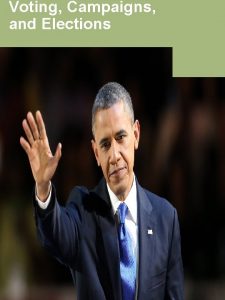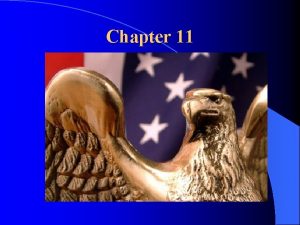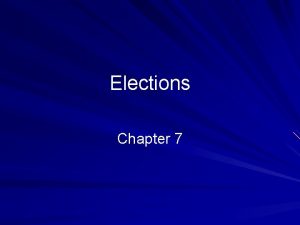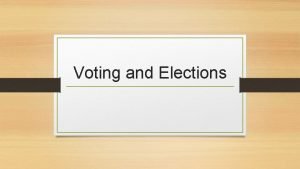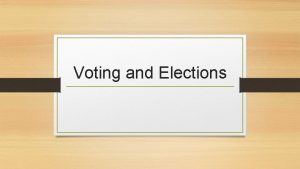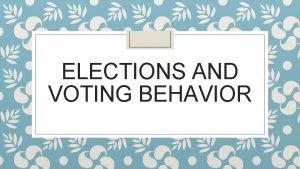AMERICAN GOVERNMENT Chapter 7 VOTING AND ELECTIONS Power























- Slides: 23

AMERICAN GOVERNMENT Chapter 7 VOTING AND ELECTIONS Power. Point Image Slideshow

FIGURE 7. 1 Senator Ted Cruz (R-TX) hosts a Rally for Religious Liberty at Bob Jones University, a Christian university in Greenville, South Carolina, on November 14, 2015. Cruz announced his campaign for president on March 23, 2105, at Liberty University in Lynchburg, Virginia. (credit: modification of work by Jamelle Bouie) This Open. Stax ancillary resource is © Rice University under a CC-BY 4. 0 International license; it may be reproduced or modified but must be attributed to Open. Stax, Rice University and any changes must be noted. Any images credited to other sources are similarly available for reproduction, but must be attributed to their sources.

FIGURE 7. 2 The Voting Rights Act (a) was signed into law by President Lyndon B. Johnson (b, left) on August 6, 1965, in the presence of major figures of the civil rights movement, including Rosa Parks and Martin Luther King Jr. (b, center). This Open. Stax ancillary resource is © Rice University under a CC-BY 4. 0 International license; it may be reproduced or modified but must be attributed to Open. Stax, Rice University and any changes must be noted. Any images credited to other sources are similarly available for reproduction, but must be attributed to their sources.

FIGURE 7. 3 Moving requires a voter to re-register or update his or her address in the system. Depending on the state, this notification can sometimes be completed through the Department of Motor Vehicles, as in California. This Open. Stax ancillary resource is © Rice University under a CC-BY 4. 0 International license; it may be reproduced or modified but must be attributed to Open. Stax, Rice University and any changes must be noted. Any images credited to other sources are similarly available for reproduction, but must be attributed to their sources.

FIGURE 7. 4 On National Voter Registration Day in 2012, Roshaunda Mc. Lean (a, left), campus director of the Associated Students of the University of Missouri, and David Vaughn (a, right), a Missouri Student Association senator, register voters on campus. Cassie Dorman (b, left) and Samantha Peterson (b, right), both eighteen years old, were just two of the University of Missouri students registering to vote for the first time. (credit a, b: modification of work by “KOMUnews”/Flickr) This Open. Stax ancillary resource is © Rice University under a CC-BY 4. 0 International license; it may be reproduced or modified but must be attributed to Open. Stax, Rice University and any changes must be noted. Any images credited to other sources are similarly available for reproduction, but must be attributed to their sources.

FIGURE 7. 5 Rock the Vote works with musicians and other celebrities across the country to encourage and register young people to vote (a). Sheryl Crow was one of Rock the Vote’s strongest supporters in the 2008 election, subsequently performing at the Midwest Inaugural Ball in January 2009 (b). (credit a: modification of work by Jeff Kramer; credit b: modification of work by “cliff 1066”/Flickr) This Open. Stax ancillary resource is © Rice University under a CC-BY 4. 0 International license; it may be reproduced or modified but must be attributed to Open. Stax, Rice University and any changes must be noted. Any images credited to other sources are similarly available for reproduction, but must be attributed to their sources.

FIGURE 7. 6 There are many ways to measure voter turnout depending on whether we calculate it using the total population, the voting-age population (VAP), the voting-eligible population (VEP), or the total number of registered voters. This Open. Stax ancillary resource is © Rice University under a CC-BY 4. 0 International license; it may be reproduced or modified but must be attributed to Open. Stax, Rice University and any changes must be noted. Any images credited to other sources are similarly available for reproduction, but must be attributed to their sources.

FIGURE 7. 7 On January 7, 2008, John Mc. Cain campaigned in New Hampshire among voters holding AARP signs (a). AARP, formerly the American Association of Retired Persons, is one of the most influential interest groups because senior citizens are known to vote at nearly double the rate of young people (b), thanks in part to their increased reliance on government programs as they age. (credit a: modification of work by Ryan Glenn) This Open. Stax ancillary resource is © Rice University under a CC-BY 4. 0 International license; it may be reproduced or modified but must be attributed to Open. Stax, Rice University and any changes must be noted. Any images credited to other sources are similarly available for reproduction, but must be attributed to their sources.

FIGURE 7. 8 This Open. Stax ancillary resource is © Rice University under a CC-BY 4. 0 International license; it may be reproduced or modified but must be attributed to Open. Stax, Rice University and any changes must be noted. Any images credited to other sources are similarly available for reproduction, but must be attributed to their sources.

FIGURE 7. 9 On November 5, 2008, union members get ready to hit the streets in Milwaukee, Wisconsin, to “get out the vote” (GOTV) for Barack Obama (a). On August 23, 2008, the Obama campaign texted supporters directly in order to announce that he had selected Senator Joe Biden (D-DE) as his running mate (b). (credit a: modification of work by Casie Yoder; credit b: modification of work by “brownpau”/Flickr) This Open. Stax ancillary resource is © Rice University under a CC-BY 4. 0 International license; it may be reproduced or modified but must be attributed to Open. Stax, Rice University and any changes must be noted. Any images credited to other sources are similarly available for reproduction, but must be attributed to their sources.

FIGURE 7. 10 On February 5, 2008, dubbed “Super Duper Tuesday” by the press, twenty-four states held caucuses or primary elections—the largest simultaneous number of state presidential primary elections in U. S. history. As a result, over half the Democratic delegates were allocated unusually early in the election season. This polling station, on the Stanford University campus in Palo Alto, California, had long lines, commonly seen only on Election Day, and nearly ran out of Democratic ballots. (credit: Josh Thompson) This Open. Stax ancillary resource is © Rice University under a CC-BY 4. 0 International license; it may be reproduced or modified but must be attributed to Open. Stax, Rice University and any changes must be noted. Any images credited to other sources are similarly available for reproduction, but must be attributed to their sources.

FIGURE 7. 11 Those who seek elected office do not generally reflect the demographics of the general public: They are often disproportionately male, white, and more educated than the overall U. S. population. This Open. Stax ancillary resource is © Rice University under a CC-BY 4. 0 International license; it may be reproduced or modified but must be attributed to Open. Stax, Rice University and any changes must be noted. Any images credited to other sources are similarly available for reproduction, but must be attributed to their sources.

FIGURE 7. 12 This Open. Stax ancillary resource is © Rice University under a CC-BY 4. 0 International license; it may be reproduced or modified but must be attributed to Open. Stax, Rice University and any changes must be noted. Any images credited to other sources are similarly available for reproduction, but must be attributed to their sources.

FIGURE 7. 13 Presidential candidates often spend a significant amount of time campaigning in states with early caucuses or primaries. In September 2015, Senator Bernie Sanders (a), a candidate for the Democratic nomination, speaks at the Amherst Democrats BBQ in Amherst, New Hampshire. In July 2015, John Ellis “Jeb” Bush (b), former Republican governor of Florida, greets the public at the Fourth of July parade in Merrimack, New Hampshire. (credit a, b: modification of work by Marc Nozell) This Open. Stax ancillary resource is © Rice University under a CC-BY 4. 0 International license; it may be reproduced or modified but must be attributed to Open. Stax, Rice University and any changes must be noted. Any images credited to other sources are similarly available for reproduction, but must be attributed to their sources.

FIGURE 7. 14 Reince Priebus, chairman of the Republican National Committee, opens the Republican National Convention in Tampa, Florida, on August 28, 2012 (a). Pageantry and symbolism, such as the flag motifs and political buttons shown on this Wisconsin attendee’s hat (b), reign supreme during national conventions. (credit a, b: modification of work by Mallory Benedict/PBS News. Hour) This Open. Stax ancillary resource is © Rice University under a CC-BY 4. 0 International license; it may be reproduced or modified but must be attributed to Open. Stax, Rice University and any changes must be noted. Any images credited to other sources are similarly available for reproduction, but must be attributed to their sources.

FIGURE 7. 15 Sailors on the USS Mc. Campbell, based out of Yokosuka, Japan, watch the first presidential debate between President Barack Obama and former Massachusetts governor Mitt Romney on October 4, 2012. This Open. Stax ancillary resource is © Rice University under a CC-BY 4. 0 International license; it may be reproduced or modified but must be attributed to Open. Stax, Rice University and any changes must be noted. Any images credited to other sources are similarly available for reproduction, but must be attributed to their sources.

FIGURE 7. 16 In 2004, Minnesota had an error or faithless voter when one elector cast a vote for John Edwards for president (a). On July 8, 2004, presidential candidate John Kerry and his running mate John Edwards arrive for a campaign rally in Fort Lauderdale, Florida (b). (credit b: modification of work by Richard Block) This Open. Stax ancillary resource is © Rice University under a CC-BY 4. 0 International license; it may be reproduced or modified but must be attributed to Open. Stax, Rice University and any changes must be noted. Any images credited to other sources are similarly available for reproduction, but must be attributed to their sources.

FIGURE 7. 17 EMILY’s List candidates include members of Congress, such as Tammy Duckworth (DIL) (a), and governors, such as Maggie Hassan (b) of New Hampshire, who is currently running for U. S. Senate. (credit b: modification of work by Roger H. Goun) This Open. Stax ancillary resource is © Rice University under a CC-BY 4. 0 International license; it may be reproduced or modified but must be attributed to Open. Stax, Rice University and any changes must be noted. Any images credited to other sources are similarly available for reproduction, but must be attributed to their sources.

FIGURE 7. 18 In February 2008, Chuck Norris speaks at a rally for Mike Huckabee in College Station, Texas. (credit: modification of work by “ensign_beedrill”/Flickr) This Open. Stax ancillary resource is © Rice University under a CC-BY 4. 0 International license; it may be reproduced or modified but must be attributed to Open. Stax, Rice University and any changes must be noted. Any images credited to other sources are similarly available for reproduction, but must be attributed to their sources.

FIGURE 7. 19 The infamous “Coffin Handbill” used by John Quincy Adams against Andrew Jackson in the 1828 presidential election. This Open. Stax ancillary resource is © Rice University under a CC-BY 4. 0 International license; it may be reproduced or modified but must be attributed to Open. Stax, Rice University and any changes must be noted. Any images credited to other sources are similarly available for reproduction, but must be attributed to their sources.

FIGURE 7. 20 Voters in Michigan can use straight-ticket voting. To fill out their ballot, they select one box at the top to give a single party all the votes on the ballot. This Open. Stax ancillary resource is © Rice University under a CC-BY 4. 0 International license; it may be reproduced or modified but must be attributed to Open. Stax, Rice University and any changes must be noted. Any images credited to other sources are similarly available for reproduction, but must be attributed to their sources.

FIGURE 7. 21 This map shows which states allow citizens to place laws and amendments on the ballot for voter approval or repeal. This Open. Stax ancillary resource is © Rice University under a CC-BY 4. 0 International license; it may be reproduced or modified but must be attributed to Open. Stax, Rice University and any changes must be noted. Any images credited to other sources are similarly available for reproduction, but must be attributed to their sources.

FIGURE 7. 22 Caption: In 2014, Florida voters considered a proposed amendment to the Florida constitution that would allow doctors to recommend the use of marijuana for patient use. The ballot initiative received 58 percent of the vote, just short of the 60 percent required to pass in Florida. This Open. Stax ancillary resource is © Rice University under a CC-BY 4. 0 International license; it may be reproduced or modified but must be attributed to Open. Stax, Rice University and any changes must be noted. Any images credited to other sources are similarly available for reproduction, but must be attributed to their sources.
 Membership of imf
Membership of imf Presidential elections exploration and announcement
Presidential elections exploration and announcement Governing marriage laws and conducting elections
Governing marriage laws and conducting elections African charter on democracy, elections and governance
African charter on democracy, elections and governance Chapter 2 american government
Chapter 2 american government Origins of american government vocabulary
Origins of american government vocabulary Chapter 2 origins of american government answer key
Chapter 2 origins of american government answer key Chapter 2: origins of american government worksheet answers
Chapter 2: origins of american government worksheet answers Chapter 2 lesson 1 government in colonial america answers
Chapter 2 lesson 1 government in colonial america answers Chapter 2 origins of american government
Chapter 2 origins of american government Chapter 4 federalism answer key
Chapter 4 federalism answer key Power trianlge
Power trianlge Pros and cons of additional member system
Pros and cons of additional member system Stalin promise free elections
Stalin promise free elections David becker elections
David becker elections Conclusion on elections
Conclusion on elections Ap lang synthesis essay television presidential elections
Ap lang synthesis essay television presidential elections “elections are key to democracy”
“elections are key to democracy” Chapter 11 section 2 american power tips the balance
Chapter 11 section 2 american power tips the balance Chapter 19 section 4 wilson fights for peace
Chapter 19 section 4 wilson fights for peace National powers
National powers Voting behaviour essay
Voting behaviour essay Voting rights
Voting rights Voting by feet tiebout
Voting by feet tiebout
